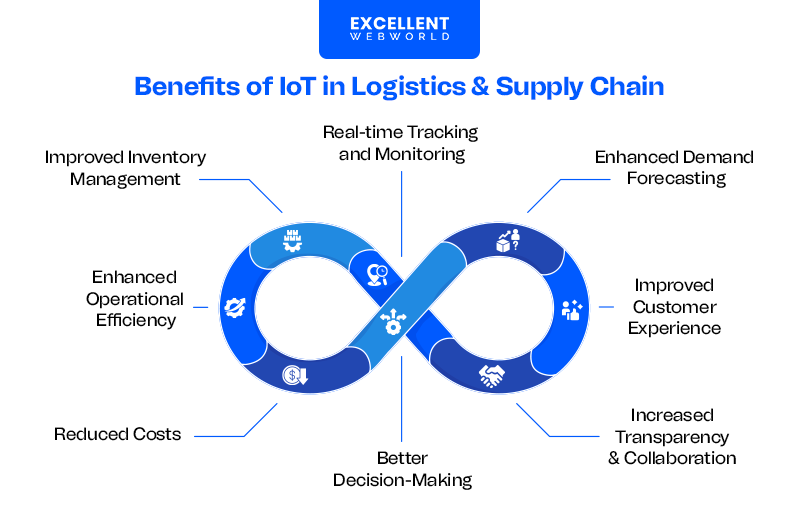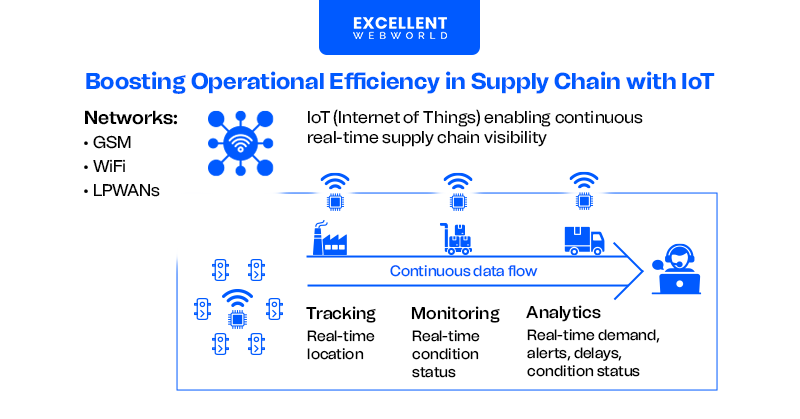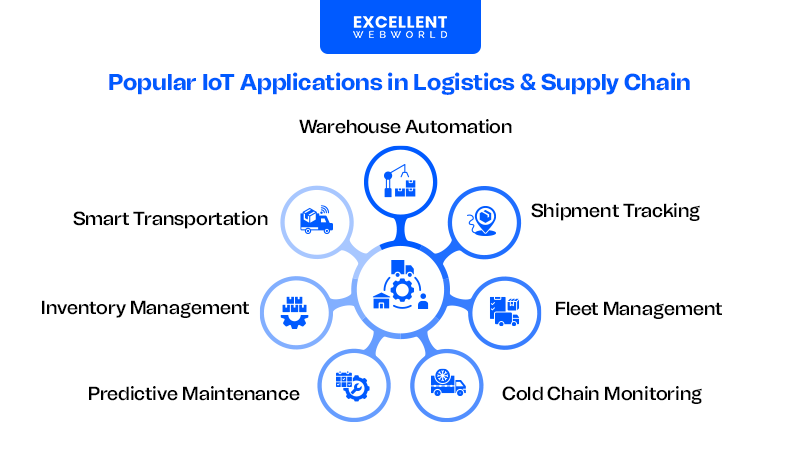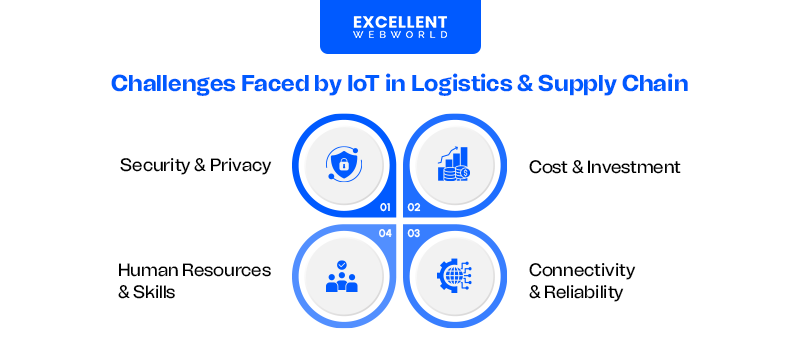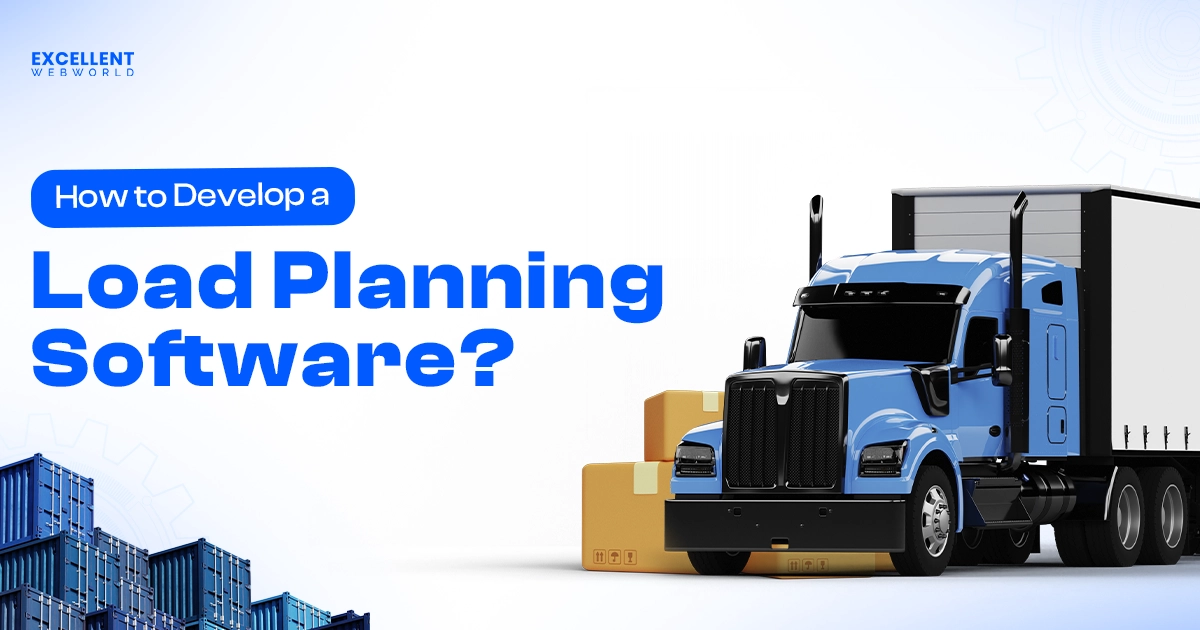Smart technology serves smart solutions. The concept of the Internet of Things (IoT) aims to create a smart world that streamlines tasks and increases networking efficiency. With many industries, IoT in logistics and supply chains has proven its worth by boosting efficiency and managing connectivity tasks.
If you are a business owner looking for a solution that helps in optimizing logistics, higher operational costs, delayed deliveries, poor supply chain management, or inefficient tracking, then IoT is for you. In terms of scope, IoT is already ruling with USD 50.26 million in the logistics market (Source: Future Market Insights). That means it’s worth investing in IoT trends to boost supply chain efficiency and stay ahead in the competitive edge.
In this blog, we are going to explore everything related to the Internet of Things in logistics, including benefits, use cases, challenges, and cost-effective implementation strategies. Let’s begin!
Statistics of IoT in Logistics and Supply Chain Management
The IoT in the supply chain and logistics industry has grown dramatically and created lots of opportunities for businesses while strengthening their transportation, warehouse, & shipping systems.
IoT offers multiple benefits for the logistics industry, such as enhancing efficiency, transparency, and operational effectiveness. Recent statistics on IoT in supply chain management and logistics justify its growing impact and benefits.
Top 8 Benefits of IoT in Supply Chain and Logistics
Utilizing IoT in logistics and supply chain management is highly promising, as it comes with numerous advantages that result in effective operational efficiency. Let’s look at some benefits of IoT in logistics and supply chain.
1. Real-time Tracking and Monitoring
You can track and monitor your shipment in real time by integrating IoT into your logistics systems. There are IoT-enabled location tracking apps and GPS devices that allow businesses to check the accurate location of their goods.
This serves greater transparency, which ultimately leads to reducing delays and making quicker decisions. With this, you can enhance customer experience and satisfaction, which brings customer retention and loyalty to your services.
2. Improved Inventory Management
Inventory management is one of the significant benefits of IoT in supply chain and logistics. Different IoT sensors integrated with warehouse management systems help you track your exact stock level in real time. With this data, you can avoid overstocking or storing extra items.
The automated IoT systems can easily track the live movements of products within the warehouse. Also, it makes sure that every item is stored efficiently in its respective place to be accessed easily. Businesses make the best use of barcodes and RFID inventory management with IoT to track all the items with detailed information.
3. Enhanced Operational Efficiency
IoT devices help automate and streamline many operations within the logistics and supply chain industries. It can track real-time data and monitor warehouse data, inventory shipments, and delivery vehicles. This leads to better coordination and optimized route planning, which ultimately reduces delays, minimizes human errors, and ensures that operations run smoothly.
May You Want to Read: Smart Livestock Management With IoT Solutions
4. Reduced Costs
This benefit of IoT in supply chain and logistics is what every business owner wants. A strategic investment in IoT solutions can reduce operational costs in the long term. The IoT-enabled automation leads to optimizing resources that help in reducing cost.
Real-time tracking prevents overstocking and understocking, which helps you manage waste and storage costs. With IoT, you can get information on the predictive maintenance of equipment, which also saves you from the major cost of unexpected breakdowns.
Furthermore, IoT in transportation and logistics can optimize delivery truck routes and find the easiest and fastest way to reach delivery locations; this minimizes fuel consumption and transportation costs.
5. Better Decision-Making
With the wealth of accurate data, IoT allows you to make the right decisions for logistics and supply chain related operations. This helps logistics businesses adjust their operations quickly in respective to demand fluctuations, supply shortages, or potential disruptions. Ultimately, you can do better strategic planning and risk management.
6. Increased Transparency and Collaboration
IoT in shipping and logistics enhances the visibility across the entire supply chain data, allowing stakeholders to track the shipment and inventory status at any time. This establishes transparency and enhances better communication & collaboration between suppliers, distributors, and customers.
All this prevents miscommunication and delays, helping all parties to coordinate effortlessly. Moreover, transparency improves trust and credibility among partners and customers.
7. Improved Customer Experience
IoT technology can highly improve the customer experience by serving better visibility and reliability in the delivery process. After placing an order, customers have access to the potential data on real-time order status, accurate estimated delivery times, and alerts to any possible delays.
This level of direct transparency builds purchase confidence in a customer. Moreover, IoT helps in efficient operations that reduce the risk of shipping errors, which ensures that customers receive their products on time and in good condition.
This type of quality service can increase customer retention and loyalty. You can connect with a top custom IoT product development company to build your tailored IoT solution that helps you achieve a high rate of customer satisfaction.
8. Enhanced Demand Forecasting
With the accuracy and collective information on real-time data, IoT in supply chain and logistics helps make more informed predictions about future demand. So, the supply chain operators can adjust their production and distribution decisions and strategies according to the customer’s need. This can prevent wrong item stocking and demanded product deficiency.
Wondering how is IoT used in supply chain and logistics? Then continue reading to the next section because it explains all the key use cases of IoT in logistics and supply chain management with prominent examples.
7 Best IoT Applications in Logistics and Supply Chain [ + Real-World Examples]
Industry leaders have already shown huge use cases of IoT technology. They preferred to integrate IoT technology into a fundamental system of logistics and supply chain management operations. Here are the seven most notable IoT applications to help you understand the worth of this technology for the logistics industry.
1. Warehouse Automation
IoT is one of the most prominent warehouse automation technologies that automate crucial processes such as inventory management, order picking, and sorting. IoT-enabled smart sensors, robotic systems, and connected equipment can make tracking goods, managing stock levels, and optimizing storage space real.
With this automation, you can achieve fewer human errors, increased throughput, and faster order fulfillment. Hence, it boosts the overall productivity of warehouse operations.
Amazon is using IoT-enabled robots (like Kiva robots) to move inventory around the warehouse. These robots are integrated with warehouse management systems.
2. Shipment Tracking
With the implementation of IoT in shipping and logistics, real-time visibility into the location and status of goods in transit becomes possible. IoT-enabled shipment tracking involves the use of connected sensors.
With GPS, RFID tags, and temperature sensors, you can monitor everything regarding your shipment, including tracking delays, preventing theft, and ensuring accurate delivery times. This leads to improvement in customer services, operational efficiency, and transparency in the supply chain.
Maersk, a global leader in shipping and logistics, implemented IoT tech for real-time shipment tracking through its Remote Container Management (RCM) system.
3. Fleet Management
The IoT fleet management solutions help in monitoring and optimizing the performance of delivery trucks and other associated vehicles in real-time. Telematics systems and GPS can track live vehicle locations, fuel consumption, vehicle capacity, driving behavior, and vehicle health.
With these crucial details, you can improve route planning, reduce transportation and other operational costs, and ensure on-time deliveries. Ultimately, this will save you from unnecessary costs and maintain vehicle safety & compliance.
UPS uses IoT at an extensive level in its fleet management. Their Orion system optimizes delivery routes by analyzing traffic data, vehicle performance, and environmental conditions in real-time.
4. Cold Chain Monitoring
For those industries that have to deal with perishable goods, such as food and pharmaceuticals, cold chain monitoring is crucial. Integrating industrial IoT solutions that have temperature and humidity sensors can consistently monitor and report the real-time conditions of goods.
This is essential to keep your products in optimal conditions at the time of storage, transport, and delivery, which prevents them from any kind of expiration. Moreover, it can reduce your waste, ensure product quality, and comply with regulatory standards in case of temperature-sensitive logistics shipments.
Pfizer, a pharmaceutical company, uses IoT-powered cold chain monitoring systems to track the temperature of vaccines throughout transportation.
5. Predictive Maintenance
The IoT-powered predictive maintenance sensors detect early signs of unexpected equipment failures or malfunctions in logistics and supply chain operations. By monitoring the conditions of machines, vehicles, and other assets, IoT in the logistics system predicts the maintenance need before any costly failure occurs.
This type of IoT-based logistics app development will help you minimize downtime, extend the life of machines, reduce high maintenance costs, and make you operate smoothly throughout the process.
Caterpillar, a machinery manufacturer, integrated IoT-enabled predictive maintenance (Cat Connect) on its fleet of construction equipment.
6. Inventory Management
IoT-integrated inventory management systems use RFID tags, sensors, and automated tracking. This implementation of IoT in logistics helps you to keep an eye on the exact numbers of stock level, manage restoration, and optimize storage capacity.
You can make smart decisions considering the real-time data collection. This gives you large visibility on stock movements, prevents stockouts, and reduces overstocking. Thus, smart waste management, operation management, and accuracy can be achieved across the supply chain with IoT technology.
Walmart employs IoT-based RFID tags and sensors in its inventory management system to track real-time stock levels across its numerous retail outlets.
7. Smart Transportation Facilities
IoT app development for smart transportation includes features like traffic management systems, intelligent transportation networks, and automated loading & unloading. Sensors embedded in transport places (airports, ports, distribution centers, etc.) collect and analyze real-time data.
This gives visibility to traffic flow optimization, manages obstruction, and boosts the overall efficiency of transporting goods. Hence, IoT in transportation and logistics is contributing to cost saving, improving delivery services and business processes.
The Port of Rotterdam, one of the busiest ports in the world, has implemented IoT technology to enhance its smart transportation facilities. The movement of containers and traffic flow can easily be managed with the IoT solutions.
Challenges of IoT in Supply Chain and Logistics
Here is an overview of key challenges faced by business owners for using IoT in logistics and supply chain management, along with their reliable solutions:
Security and Privacy
IoT software collects sensitive data of logistics companies, which makes them at risk to cyberattacks, data breaches, and unauthorized access.
Solution: Never compromise with weak encryption for affordable rates. Implement robust encryption, secure data transmission, and do security updates on a regular basis. Opting for multi-factor authentication and network segmentation can also help in reducing cyber risks.
Human Resources and Skills
The integration of IoT in logistics needs specialized skills and talent, and there may be chances of having a shortage of workers with expertise in IoT technology, as it’s an emerging trend.
Solution: Invest in training programs for your workers. You can hire IoT specialists and collaborate with IoT software development company to upskill the workforce and gain more info on IoT tech.
Connectivity and Reliability
The IoT software depends on continuous connectivity. Unexpected network issues, especially in remote areas, can disturb the data transmission and delay the overall process.
Solution: Use a high-speed communication network connection such as 5G, satellite, or LPWAN (Low Power Wide Area Network) to ensure unbreakable connectivity. If possible, then employ backup systems for reliability.
Cost and Investment
The cost of implementing IoT solutions is a little high in the beginning, including devices, software, and infrastructure. Every business owner can’t make it all at once as per their capital, and sometimes it becomes tough to convince or find investors for IoT integrations due to lack of awareness.
Solution: Start with scalable IoT solutions that can grow with the business. If you are customizing it for your logistics business, then try MVP development for IoT at first to address core needs in the beginning.
IoT Implementation Strategies: Best Practices for Logistics Business Owners
Similar to other technologies, the implementation of IoT in logistics and supply chain requires a lot of planning and skillset. A great investment and better customization are crucial aspects of integrating IoT in logistics systems.
It’s not enough to simply purchase and start using IoT devices for business optimization and other associated benefits. Here are some best practices mentioned to achieve success with IoT integration:
Top 3 Future Trends of IoT in Logistics and Supply Chain
The Internet of Things in supply chain management and logistics industry continues to evolve and bring transformative changes. As we look into the future, many emerging technologies that are associated with IoT give innovative solutions to streamline logistics and supply chain operations.
Here are the top three must-know trends that brighten the future of IoT based supply chain management and logistics operations.
1. Autonomous Vehicles and Drones
IoT enhancements are driving the increase in the use of smart drones and autonomous vehicles for goods delivery. The IoT fleet management technologies are streamlining delivery processes with improved delivery times and reducing operational costs.
2. Blockchain Technology
Blockchain integration with IoT for supply chain management and logistics could revolutionize data management. It can create a more secure and transparent way of data transaction and tracking for the logistics industry.
3. AI Integrations
The use of AI in logistics and supply chains improves the efficiency of IoT networks by optimizing data transmission and reducing network bottlenecks. With the analysis of network traffic in real time, AI can identify the most efficient routes for data transmission. All these lead to improved network performance and consistency in IoT-based operations.
Read Also: Importance of IoT in Daily Life
Final Words: IoT – The Key to Logistics & Supply Chain Success
The implementation of IoT in logistics and supply chain management is definitely transforming the industry like never before. By providing real-time data insights, boosting operational efficiency, and ensuring better decision-making, IoT is the great essence for businesses that want to streamline their processes and thrive.
There are some challenges with IoT integrations, like security, connectivity, and investments, but that can be manageable with the right implementation strategies. From shipment tracking to predictive maintenance, every IoT application is crafted for logistics and supply chain success. Utilizing IoT for your business is no longer an option. In fact, it’s the key to staying ahead of the competition with digital formulas.
Take a trending step for your logistics business by connecting with a prominent IoT development company like Excellent Webworld, which has years of experience in IoT-based hardware and software advancements. We will guide you throughout the IoT development process and craft a solution for you that gives you only efficiency and success to get a better ROI.
Frequently Asked Questions (FAQs)
IoT in logistics is meant to use connected devices integrated with IoT technology to track, manage, and optimize supply chain processes in real-time.
IoT is an emerging technology trend that helps logistics businesses streamline their operations. It will drive automation, real-time tracking, and data-driven decision-making. All these improve efficiency and reduce costs.
Amazon uses IoT for warehouse automation. At major, IoT helps in real-time shipment tracking and inventory management with smart devices.
IoT devices like GPS trackers, RFID tags, sensors, and robots are used for tracking and managing inventory and shipments.
Top companies like Amazon, Walmart, UPS, Maersk, and Pfizer use IoT to improve logistics and supply chain operations efficiency.

Article By
Mayur Panchal is the CTO of Excellent Webworld. With his skills and expertise, He stays updated with industry trends and utilizes his technical expertise to address problems faced by entrepreneurs and startup owners.

